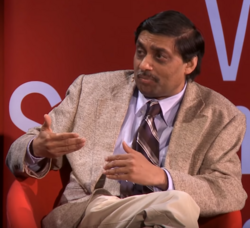Biography:Samir D. Mathur
Samir D. Mathur | |
|---|---|
 Prof. Samir Mathur | |
| Born | Samir Dayal Mathur karur |
| Alma mater | IIT Kanpur (M.S., 1981) TIFR (Ph.D., 1987) |
| Known for | Fuzzball (string theory) Contributions to: String Theory AdS/CFT Black hole information paradox |
| Scientific career | |
| Fields | Physics |
| Institutions | Ohio State University MIT |
Samir Dayal Mathur is a theoretical physicist who specializes in string theory and black hole physics. Mathur is a professor in the Department of Physics at The Ohio State University and a member of the University's High Energy Theory Group. He was a faculty member at Massachusetts Institute of Technology from 1991–99 and held postdoctoral positions at Harvard University and the Tata Institute of Fundamental Research.[1]
Mathur's research is focused on string theory, black holes, the AdS/CFT correspondence, and cosmology. He is best known for developing the Fuzzball conjecture as a resolution of the black hole information paradox. The Fuzzball conjecture asserts that the fundamental description of black holes is given by a quantum bound state of matter which has the same size as the corresponding classical black hole.[2] This quantum bound state replaces the event horizon and singularity, and the classical black hole metric is claimed to be an approximate effective description.[3]
In 2009 Mathur published a strong version of the black hole information paradox, strengthening Stephen Hawking's original version by demonstrating that small local corrections to Hawking's semiclassical analysis cannot restore unitarity.[4] This result was obtained by applying Strong Subadditivity of Quantum Entropy to the evaporation of Hawking radiation.[4] This led to a renewed interest in the information paradox and the development of the 2012 black hole firewall paradox.[5][6][7]
References
- ↑ Faculty information sheet. The Ohio State University. Archived from the original on 2015-04-04. https://archive.is/20150404112037/https://physics.osu.edu/people/mathur. Retrieved 2015-03-29.
- ↑ Samir D. Mathur (2005). "The Fuzzball proposal for black holes: An Elementary review". Fortsch. Phys. 53: 793. doi:10.1002/prop.200410203. Bibcode: 2005ForPh..53..793M.
- ↑ Samir D. Mathur (2012). "Black Holes and Beyond". Annals of Physics 327: 2760. doi:10.1016/j.aop.2012.05.001. Bibcode: 2012AnPhy.327.2760M.
- ↑ 4.0 4.1 Samir D. Mathur (2009). "The Information paradox: A Pedagogical introduction". Class. Quantum Grav. 26: 224001. doi:10.1088/0264-9381/26/22/224001. Bibcode: 2009CQGra..26v4001M.
- ↑ Jennifer Ouellette, "The Fuzzball Fix for a Black Hole Paradox", Quanta magazine, June 23, 2015. https://www.quantamagazine.org/20150623-fuzzballs-black-hole-firewalls
- ↑ Chowdhury Borun D., Puhm Andrea. "Decoherence and the fate of an infalling wave packet: Is Alice burning or fuzzing?". Phys. Rev. D 88: 063509. doi:10.1103/PhysRevD.88.063509. Bibcode: 2013PhRvD..88f3509C.
- ↑ Burrington Benjamin A., Peet Amanda W., Zadeh Ida G.. "Operator mixing for string states in the D1-D5 CFT near the orbifold point". Phys. Rev. D 87: 106001. doi:10.1103/PhysRevD.87.106001. Bibcode: 2013PhRvD..87j6001B.
External links
- Mathur's web page at The Ohio State University
- List of Publications on INSPIRE-HEP
- Information paradox solved? If so, Black Holes are "Fuzzballs" — by The Ohio State University
- KITP Seminar: The Black Hole Story in 4 Steps | Samir Mathur

